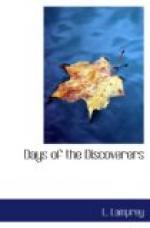To John Hudson the voyage was a journey of enchantment. Nothing he had ever seen was in the least like the glory of the autumn forests, mantling the mountains in scarlet, gold, malachite, russet, orange and purple. He had been in the gardens at Lambeth where Tradescant the famous gardener ruled, but there was more color in a single vivid maple standing blood-red in a bit of lowland than in all his Lancaster roses. And the great river had its flowers as well. A tall plant like an elfin elm covered with thick-set tiny blossoms yellow as broom, grew wild over the pastures, and interspersed with this fairy forest were thickets of deep lavender daisies with golden centers. In lowland glades were tall spikes of cardinal blossoms, and clusters of deep blue flowers like buds that never opened. Vines loaded with bunches of scarlet and orange berries like waxwork, and others bearing fluffy bunches of silky gray down curly as an old man’s beard, climbed the trees that overhung the stream. The mountains in the upper river came right down to the water like the glacis of a giant fort, and fitful winds pounced upon the Half Moon and rocked her like a cradle. Once there was a late thunder-shower, and the noise of the thunder among the humped ranges was for all the world like balls rolling in a great game of bowls played by goblins of the mountains.
On the fourth of October, the Half Moon left the island which the Indians called Manahatta, passed through the Narrows and sailed for Europe. Looking back at those green shores with their bronze feather-crowned people watching to see the flight of their strange guest, John Hudson felt that when he was a man, he would like nothing better than to have an estate on the shores of the noble river, which no white boy had ever before set eyes on. Where a great terrace rose, some fifty miles above Manahatta, walled around by mountains and almost two hundred feet above the river, there should be a fort, of which Captain John Smith should be the commander; and in the broadening of the river below to form an inland sea, his father’s squadron should ride, while the Indians of all the upper reaches of the river should come to pay tribute and bring wampum, furs and tobacco in exchange for trinkets. And on the island at the mouth of the river there would be a great city, greater than Antwerp, to which all the ships of the world should come as they came now to Antwerp and to London. So dreaming, John Hudson saw the shores of this new world vanish in the blue line, where earth and sky are one.
NOTES
[1] The kindling of bonfires and beacon lights on the accession of a sovereign or any other occasion of national rejoicing is a very old custom in Britain and is still kept up. At the time of Queen Victoria’s jubilee trees were planted closely to form a great V on the side of the Downs, and when the fires were lighted on Ditchling Beacon and other heights the letter stood out black against the close turf of the hillside.




